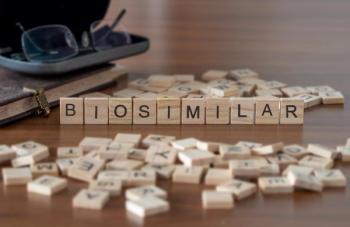
Pharmacy Practice in Focus: Health Systems
- September 2023
- Volume 12
- Issue 5
Defining Value in a Biosimilar Strategy Depends on Perspective
Enhanced utilization of biosimilar products can have significant impact on reducing the overall cost of health care and potentially reducing out-of-pocket costs for patients.
In the September 2023 issue of Pharmacy Times Health-System Edition, Jim Lichauer, PharmD, BCPS, FASHP, provides a brief report of savings achieved through a multihospital collaborative to implement biosimilar strategies resulting in a reduced expenditure of approximately $40 million across 16 institutions, or close to $3 million per site on average for the 14 sites that achieved improvement. The combined reduction in spend for innovator and biosimilar products was 12.5%.1 This report demonstrates the significant potential that enhanced utilization of biosimilar products can have on reducing the overall cost of health care and potentially reducing out-of-pocket costs for patients. Lichauer and his collaborators should be recognized for this achievement.
However, it is important to acknowledge that the total picture of the cost and financial value is dependent on perspective, like most financial analyses. Who derives the greatest value from this reduced acquisition cost? The health system provider, the payer, the patient, or, ultimately, society?
First, several payers will dictate which reference or biosimilar product will be reimbursed, which limits the ability of a health system to implement a coherent strategy. Because of other financial relationships, the payers often force higher acquisition costs on providers, and greater out-of-pocket costs on patients, to achieve a lower net cost for the payer. These variable and inconsistent reimbursement policies across payers will also increase inventory carrying costs for health systems since multiple—essentially identical—products must be kept on the shelf. The risk of error also increases when providers or frontline staff may select the incorrect biosimilar product based on a patient’s insurance, resulting in a denied claim.
Second, there may be a disconnect between acquisition cost and reimbursement for the health system. That is, a less expensive biosimilar may have a higher rate of reimbursement, creating a greater margin opportunity for the health system. Alternatively, a more expensive biosimilar or reference product may have a reimbursement rate that achieves a more favorable margin, especially for a 340B-covered entity. These illogical but common situations may incentivize the health system to utilize the biosimilar with favorable reimbursement and margin, and not necessarily the lowest acquisition cost alternative. This can potentially have an adverse effect on patient out-of-pocket cost, and a higher cost for payers (although if allowed on their formulary, the payer is likely also benefiting from rebates or other discounts).
Third, as biosimilars are on the market longer, they will lose pass-through status as they move from status indicator G to K or N, which may affect reimbursement. Therefore, use of a newer biosimilar that is still status indicator G may provide a higher margin to the health system than a product with a lower acquisition cost. However, issues around reimbursement may also be affected by whether the health system is a 340B-eligible covered entity.
Overall, the cost-saving potential of biosimilars is complex and involves considering multiple factors beyond solely the pursuit of the lowest acquisition cost, when taking into account the financial perspective of interest. Most of us are often in the position of having to make decisions from the perspective of our health system while also trying to minimize the financial impact those decisions may have on our patients. We typically do not have enough insight into the payer’s perspective, but their business decisions are typically driven by their lowest net cost, which may or may not translate to the lowest costs for others. Health system decisions, when we have options based on payer mix, are often driven by net margin.
These complex financial considerations, and typical misalignments among the interests of payers, health systems, and patients, have been a major obstacle to a smooth, logical implementation of a biosimilar strategy that makes sense for all stakeholders. The collaborative exercise with 16 health care organizations reported by Lichauer is remarkable when considering the challenges of getting multiple health systems to be aligned on strategies. I agree with the comments in Lichauer’s article regarding the need for a multiprong strategy to be adopted, and we have found that means having dedicated staff to manage this process.
It is easy to see that the introduction of biosimilar products has greatly increased the complexity of managing these expensive products, but with the right approach we should be able to identify savings that benefit all relevant stakeholders without compromising the quality of care for patients. This is a messy process for most institutions, so developing policies that operationalize the strategy with broad support from clinicians, finance, administration, and others is essential. Of course, the next wave starting to crash onto the beach is the rapid growth of cellular and gene-based therapies with very high costs and complex payer landscapes. This is a therapeutic frontier that will likely make biosimilar implementation strategies look easy.
About the Author
Curtis E. Haas, PharmD, FCCP, is director of pharmacy for the University of Rochester Medical Center in New York.
Reference
Lichauer J. The promise of biosimilars is within reach for health systems. Pharmacy Times Health-System Edition. September 2023.
Articles in this issue
over 2 years ago
Pharmacy-Led Medication Reconciliation Is Best Practiceover 2 years ago
Ryan’s Law Is a Monumental Opportunity for Pharmacistsover 2 years ago
The Promise of Biosimilars Is Within Reach for Health SystemsNewsletter
Stay informed on drug updates, treatment guidelines, and pharmacy practice trends—subscribe to Pharmacy Times for weekly clinical insights.








































































































































































































